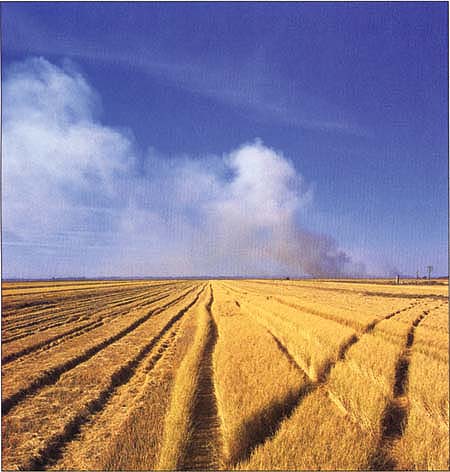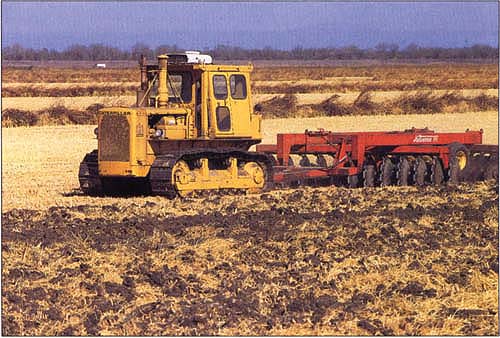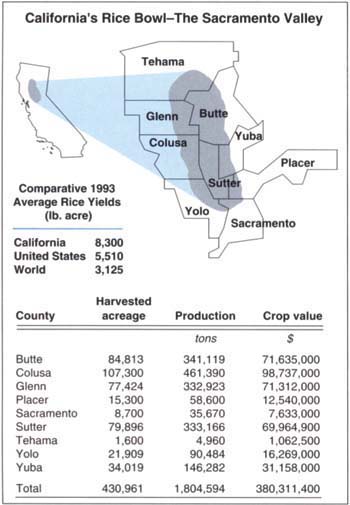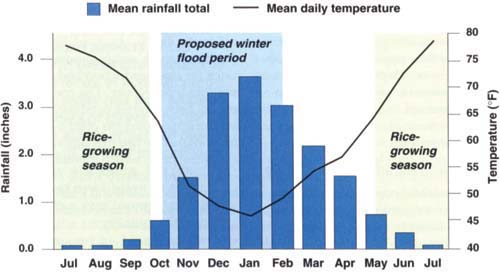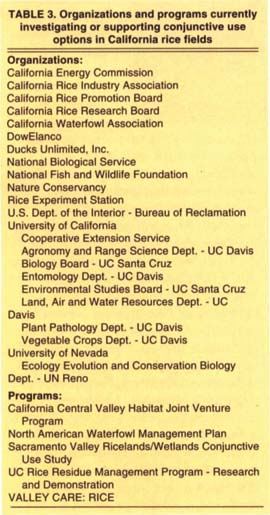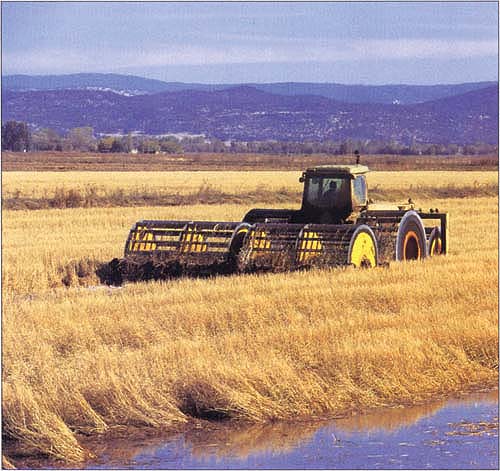All Issues
Conjunctive use of farmland adds value: Winter flooding of ricelands provides waterfowl habitat
Publication Information
California Agriculture 49(6):58-64. https://doi.org/10.3733/ca.v049n06p58
Published November 01, 1995
PDF | Citation | Permissions
Abstract
California rice fields are home to a rich diversity of plant and animal species, and are an integral component of the waterfowl habitat in the Pacific Flyway. Adoption of novel straw incorporation techniques that leave residual rice seed accessible to foraging wildlife coupled with winter flooding to create stable winter wetlands habitat should greatly improve bird health and subsequent fecundity in northern nesting grounds. From the agronomic standpoint, however, the efficacy of these incorporation techniques and their long-term impact on rice production remain to be demonstrated. Recognizing that future straw management options must meet both production agriculture and environmental stewardship objectives, the University of California has undertaken a 5-year, multidisciplinary research and demonstration program to address these issues.
Full text
Tundra swans visit a rice field reflooded after harvest. Flooding fields from October to February creates suitable winter wetland habitat for resident and migratory waterfowl.
After rice harvest, growers must dispose of 3.5 to 4 tons of straw per acre. Recent legislation mandates the phasing down of residue burning, the traditional management practice.
Commercial rice (Oryza sativa L.) production in California began in 1912, and eventually expanded to a peak of 608,000 acres in 1981. Today, about 500,000 acres are devoted to rice production and most of this land is in the Sacramento Valley (fig. 1) Current rice yields exceed 8,000 pounds per acre and are among the highest in the world. This is due in part to California's Mediterranean climate, which favors high rates of photosynthesis by virtue of its warm, dry, clear days and long growing season. In recent decades, the need to conserve water has restricted California's rice production to acreage with poor drainage that is unsuitable for other crops. California rice is grown on heavy clay soils of river valley floors and on eroded terrace soils edging the valleys. The fine texture of soils that formed under the tule swamps, created by the annual winter and spring flood events, greatly restricts deep percolation, while the terrace soils overlay an impermeable clay pan.
Ricelands managed as wetlands
Historically, California's Central Valley had over 4 million acres of natural wetlands, and the interior of Northern California provided essential habitat for 10 million to 12 million ducks and geese migrating along the Pacific Flyway. Today only 200,000 to 300,000 acres of natural wetlands habitat remain, as more than 95% have been converted to accommodate myriad anthropogenic uses including agriculture.
Rice cropping systems are unique in that they provide wetland habitat to a variety of wildlife species. Rice cultivation with flood irrigation provides an important substitute for wetlands during the summer, and most rice acreage provides good habitat for a variety of the aquatic plants, insects, crustaceans, small mammals and resident waterfowl that populated the area in its original swampy condition. A recent census found that 177 animal species (28 mammals, 27 amphibians or reptiles, and 122 birds) spend all or part of their life cycles in rice fields or associated levees, canals and riparian areas. Twenty-one of these species are classified as sensitive at the state or federal levels (table 1).
The preponderance of birds in rice fields once posed a significant threat to farmland productivity. A series of wildlife refuges was developed to attract birds away from maturing rice. However, this preharvest seed predation has been largely eliminated by the widespread adoption of shorterseason varieties that mature in 135 days as opposed to 165 days for longerseason varieties, that is, before migratory waterfowl arrive. This has largely eliminated the preharvest seed predation that earned migratory waterfowl the classification as a major rice pest.
At present, markets for rice straw are extremely limited and most growers are incorporating residues. A traditional, “dry” approach relies on adapting standard incorporation equipment, such as the stubble disc, to the fine-textured rice soils.
Even after harvest, the food available to wildlife foraging in rice fields managed as wetlands is almost as abundant as that in natural wetlands, which provide 750 pounds of food per acre. Rice fields provide about 250 pounds per acre of naturally occurring food sources such as small invertebrates, tubers, edible shoots and seeds. In addition, after harvest an average of 350 pounds per acre of rice is available to waterfowl (see sidebar p. 61 ). Fall burning of rice straw reduces residual rice seed by 30%, but after the burn, the remaining waste seed is unobscured by straw and easily accessible to waterfowl. Fall plowing, however, buries virtually all residual seed so that little remains for feeding waterfowl. These data suggest that rice fields managed as wetlands can provide as much as 600 pounds per acre, or 80% of the amount of food found in natural wetlands.
Environmental and conservation agencies have developed a keen interest in approaches to postharvest field management that include protecting waste seed and winter flooding of rice acreage. The consensus is that creating additional wetlands habitat from October to March would attract more wildlife and improve the nutritional status of migratory waterfowl. Improved nutritional status of waterfowl prior to nesting should help stabilize the population, which declined to a census low of 2.5 million in the mid-1980s (from a historical high of 10 million to 12 million).
In addition to their intrinsic habitat value, rice fields that are managed as wetlands provide several other vital, community-level functions that are only beginning to be recognized by an increasingly urban state population. Wetlands cleanse nutrients and heavy metals from runoff water, recharge groundwater supplies and provide flood protection to adjacent urban communities. As awareness of wetlands value has grown, so has the realization that it is economically impossible to restore large areas of former wetlands through public acquisition. There is also growing recognition that a good alternative to full restoration of original wetlands is the enhancement of existing farmland to play a more diverse role in the state's ecosystem.
Fig. 1. Comparative 1993 California, United States and world average rice yields, and the distribution of 1993 California rice acreage in the major rice-producing counties of the Sacramento Valley. In 1993, San Joaquin Valley counties produced an additional 71,870 tons of rice for milling on 19,430 acres (area not shown). Sources: 1993 Agricultural Commissioners' Data, California Agricultural Statistics Service (August 1994); IRRI Rice Almanac.
This is an opportune time for rice producers, environmentalists and conservationists to forge alliances that will promote the conjunctive use of rice fields such that winter wetlands habitat is created while high crop productivity is maintained. Due to growing concern over air quality in Northern California, the legislature has mandated that rice growers must phase down rice field burning, the traditional method of disposing of rice residue (straw). The bill (AB 1378, 1991) specifies that 10% less acreage will be burned each year until 1998. By the year 2000, burning will require special permits and will be restricted to a maximum of one-fourth of the planted acreage or 125,000 acres, whichever is less. At 3.5 to 4 tons per acre, the annual rice residue is substantial and its disposal has become the major challenge to maintaining current productivity. There is only theoretical interest in major off-site uses of straw such as building materials and cogeneration plants, and virtually no market, so the rice industry is receptive to new ways of disposing of straw right in the fields.
Waterfowl-friendly management
In the early 1990s, Ducks Unlimited, a waterfowl conservation group, and a consortium of other environmental and conservation interests began working with the California Rice Industry Association and other organizations to create VALLEY CARE: RICE (Conservation of Agriculture, Resources and Environment: Restoring and Improving California's Environment). The program is dedicated to promoting a waterfowl-friendly approach to straw management and advocates winter flooding and wet rolling.
A typical protocol involves quickly draining and harvesting, reflooding the basins to a depth of 2 to 6 inches, then using a roller specially designed to crush straw and stubble into the soil. This approach has the demonstrated advantage to waterfowl of preserving residual rice seed as a carbohydrate source and of creating winter habitat that fosters the growth and development of dietetically important invertebrate species.
Furthermore, wet rolling a set percentage of rice acreage annually would stabilize the amount of food available to waterfowl. Recently, variation in fall straw management practices, coupled with fluctuation in riceland acres under production, has resulted in significant yearly variation in the estimated winter carrying capacity of interior California natural and managed wetlands. For example, in 1985 there was enough residual rice to support an estimated 4.94 million ducks but in 1986 this carrying capacity had declined to 3.78 million ducks. Significantly reducing such potentially catastrophic fluctuations is a major objective of local conservation groups.
Widespread voluntary adoption of this novel straw management approach of reflooding and wet rolling will depend on demonstrating a favorable agro-economic cost-to-benefit ratio, meaning the cost is reasonable and the practice is not harmful to the farming operation. Preliminary cost comparisons of the different methods of straw incorporation favor rolling, which appears to be one of the least expensive methods. The standard technique for straw incorporation requires chopping the straw into pieces, discing the stubble into soil, and ensuring there is enough moisture for microbes to grow and decompose the stubble. The large machines that chop and disc the massive quantities of straw have a high energy cost. According to a recent analysis of the fall costs of processing straw, incorporation with a disc, plow or tiller costs from $10 to $80 per acre (table 2) while rolling a field one time costs $6 per acre at most.
However, this analysis did not include either the cost of the water for postharvest reflooding or the cost of additional spring field operations necessitated by insufficient winter straw decomposition. In addition, the cost of rolling fields may be increased by possible agronomic effects on the development and yield of the subsequent crop. Developing a better understanding of these unknowns is critical to encouraging rice growers to manage straw residue by flooding and rolling their fields.
Agronomic considerations
Little is known about how well rice straw decomposes in temperate climates under the flooded, largely anaerobic conditions typical of wet rolling, a novel technology. Somewhat more is known about straw decomposition when the temperature is suboptimal and the soil moisture varies, conditions that typify the standard nonflooded technique of straw incorporation.
The primary determinants of the rate and extent of decomposition, and therefore the subsequent nutrient availability to the rice crop, are temperature, soil water content, amount and placement of straw residue, carbon-to-nitrogen ratio in the straw, native soil fertility and oxygenation level. At ideal temperatures (microbial activity increases with temperature between 40° and 86°F) and soil moistures (60% soil water-holding capacity), aerobic decomposition is faster than anaerobic decomposition. During the late fall, winter and early spring, however, optimal ranges of temperature and soil moisture in the field tend not to overlap. For example, in Colusa County in October the daily temperature averages 64°F, which is warm enough, but the total rainfall averages only 0.60 inches, which is too dry (fig. 2). While rainfall typically increases 10-fold by January, the mean daily temperature has fallen to 46°F and microbial activity — which increases with temperature — is largely restricted.
Practical aspects of straw decomposition of particular concern to California rice producers include: (1) achieving sufficient straw breakdown to permit timely completion of the following spring's field operations such as seedbed preparation; (2) immobilization of nitrogen and other nutrients and (3) the presence of toxic decomposition metabolites during critical stages of the subsequent crop. Nitrogen immobilization can occur when straw is incorporated shortly before planting and decomposition proceeds slowly. Soil microbes require nutrients to decompose straw and can compete directly with crop roots for nitrogen and other limited nutrients. Furthermore, in flooded soils where straw is not completely decomposed, acids (acetic, butyric, formic, lactic, and propionic acids) that are toxic to rice may form. Moreover, as these acids decompose, gases (carbon dioxide, methane and hydrogen sulfide) may be released. These gases may adversely affect root development and so limit nutrient uptake, restricting plant growth. In addition, methane emission levels need to be quantified to assess potential airquality impacts of winter-flooded straw decomposition.
Fig. 2. Mean monthly rainfall total and daily temperature in Colusa County. The green shaded areas indicate the California rice growing season, and the blue shaded area indicates the proposed winter flood period.
Straw incorporation will probably change the disease dynamics including incidence, expression and severity of two fungi that are capable of significantly reducing rice yields: stem rot (Sclerotium oryzae) and aggregate sheath spot (Rhizoctonia oryzae sativae). Burning destroys the overwintering structures supporting these fungi, effectively controlling them. Without burning, fungal levels will increase, but the effects of alternative management on disease have yet to be quantified.
In addition, the change from burning to straw incorporation will dramatically alter the composition of the communities of microorganisms that decompose the straw. Little is known about the impact of winter flooding on pathogenic and beneficial microbial population densities, species composition and activities important to rice production. Similarly, scientists have yet to document many of the effects of incorporation and flooding on the vigor of weed species, the composition of weed populations and the pressure of invertebrate pest populations. The effects on weeds are particularly important because watergrass (Echinochloa spp.) and other aquatic weed species that grow in rice fields are difficult to control despite advances in chemical and integrated pest management practices.
To determine how straw incorporation will affect rice production and to help growers develop alternatives to chopping and discing, the University of California has initiated a 5-year program: Rice Residue Management Alternatives to Burning: A UC Demonstration and Research Program. The program's objectives include: (1) conducting a comprehensive survey to document the concerns of rice growers about straw management, (2) monitoring straw decomposition on commercial fields where interesting or novel straw management practices are already established and (3) establishing replicated sites where side-by-side comparisons can be made of four straw manipulation techniques, each under winter flooded and nonflooded conditions.
At the replicated sites, the straw manipulation treatments are burning; chopping and incorporating with standard tillage implements; rolling with a cage roller; and baling and removing the straw from the field. A multidisciplinary team will evaluate each method (table 3) and development recommendations that consider both production and biodiversity.
The broad discipline base required for the current research program underscores the inherent complexity of the biologically diverse rice agroecosystem. It is essential to evaluate the changes in rice culture mandated by the rice straw burning act because they may have long-term effects that either are not anticipated or are not being rigorously examined. In the case of waterfowl-friendly straw management, the prospect of winter flooding a significant portion of the rice acreage has raised two off-site concerns. First, some argue that if rice fields are flooded with surface water in early fall, they will not be able to absorb rain during a wet winter, which could cause levee overflows and localized, flash flooding. Second, some argue that flooding rice fields during a dry winter would deprive sea-run fish of the water they require. As specific alternatives are adopted by large numbers of growers, additional research may be needed to address indirect or regional effects of nonburn management alternatives.
TABLE 3. Organizations and programs currently investigating or supporting conjunctive use options in California rice fields
Postharvest flooding and wet rolling, a novel approach to rice residue incorporation, mashes straw into the soil surface to promote its decomposition. Wet rolling leaves the unharvested rice grain accessible to foraging wildlife.
Model for meshing farms, wildlife
Nationwide, population growth and urban expansion are threatening prime farmlands. Nowhere is this more true than in California's Central Valley, where explosive urban and suburban growth is replacing rich agricultural fields. A significant portion of the urban population views agriculture as an anathema, an insatiable consumer of limited natural resources. Future protection of agricultural lands may be achieved by carefully meshing sustainable production objectives with enhancement of wildlife habitat. Rice fields in the Sacramento Valley are a viable extension of managed wetlands, and the management of straw has significant cultural, chemical, biological, environmental, and economic implications for rice production and area wildlife biodiversity. The cooperative efforts between rice producers and environmental concerns offer a model for conjunctive use management of agricultural land, which maintains agricultural productivity while enhancing both wildlife habitat and public perception of the value of agricultural land.




